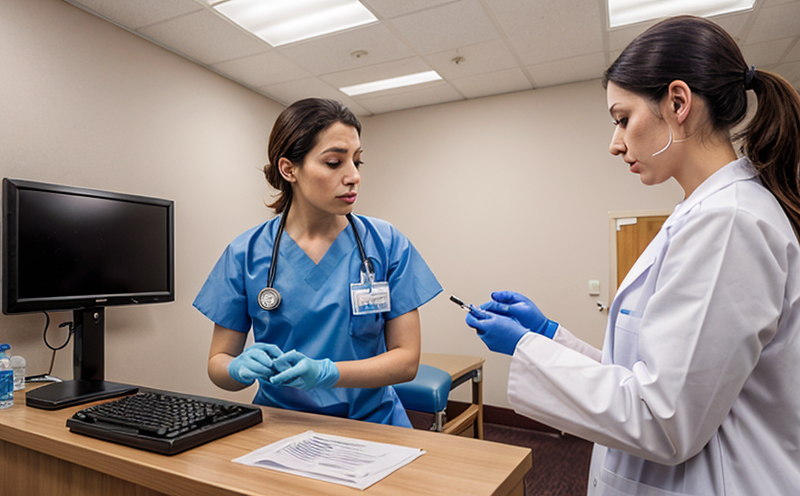Cyanotoxin Testing in Drinking and Surface Water
The presence of cyanotoxins in drinking water and surface waters poses serious health risks. Cyanotoxins are toxic secondary metabolites produced by certain species of cyanobacteria, also known as blue-green algae. These toxins can accumulate in aquatic environments under specific conditions such as nutrient enrichment, favorable temperature ranges, and low dissolved oxygen levels.
Given the potential for human exposure through drinking water or recreational activities, it is crucial to monitor these contaminants regularly. Regulatory bodies around the world are implementing stringent guidelines to ensure public health safety. For instance, the ISO 17244 standard provides a framework for the determination of microcystins in water intended for human consumption.
The testing process involves several key steps. Initially, samples are collected from different locations within the water body and transported to the laboratory under controlled conditions. The samples are then prepared using filtration techniques followed by sample preservation methods designed to prevent further contamination or degradation of cyanotoxins during transit.
Once at the lab, the analytical procedures begin with extraction and clean-up processes aimed at isolating target compounds from matrix interferences. Depending on the type of cyanotoxin being analyzed (e.g., microcystin, nodularin), specific chromatographic techniques like liquid chromatography-tandem mass spectrometry (LC-MS/MS) are employed for precise detection and quantification.
It is essential to note that no single method can detect all cyanotoxins; therefore, comprehensive screening strategies incorporating multiple analytical approaches may be necessary. Additionally, the choice of instrumentation plays a critical role in achieving reliable results. Advanced equipment such as ultra-performance liquid chromatography (UPLC), coupled with high-resolution mass spectrometry (HRMS), offers enhanced sensitivity and selectivity over traditional methods.
The importance of accurate quantification cannot be overstated when it comes to risk assessment and management decisions. Regulatory limits vary globally but generally align with World Health Organization (WHO) recommendations, which set maximum allowable concentrations for various cyanotoxins in drinking water supplies.
Understanding the environmental factors contributing to cyanotoxin blooms is equally important from a prevention standpoint. Monitoring programs should consider temperature trends, pH levels, nutrient inputs, and other ecological indicators that could trigger harmful algal growth events. By integrating this knowledge into routine sampling protocols, operators can implement targeted mitigation measures before toxic incidents occur.
Regular testing not only helps meet legal requirements but also enhances overall water quality assurance efforts. It provides valuable insights into the effectiveness of treatment processes in removing these potent neurotoxins from source waters. Furthermore, sharing results with stakeholders fosters transparency and builds trust among communities relying on clean drinking water sources.
Scope and Methodology
| Sample Collection | Preparation Techniques | Analytical Methods |
|---|---|---|
| Water samples are collected from various points within the water body. | Filtration and preservation methods to maintain integrity. | Liquid chromatography-tandem mass spectrometry (LC-MS/MS). |
| Ensure proper labeling for traceability throughout analysis. | Use appropriate solvents based on target compounds. | Detect and quantify specific cyanotoxins with high precision. |
The scope of our cyanotoxin testing services encompasses all aspects from initial sample collection through final result reporting. Our experienced team adheres strictly to established protocols outlined in relevant international standards such as ISO 17244 and EN 16583-2.
For each sampling event, detailed documentation is maintained including field notes on environmental conditions present at the time of collection. This information is vital for understanding how external factors might influence toxin levels observed in subsequent analyses.
The preparation phase involves thorough filtration steps followed by preservation procedures to prevent degradation prior to analysis. Once prepared samples reach our laboratory, they undergo rigorous quality control checks before being subjected to sophisticated instrumental methods capable of detecting even trace amounts of cyanotoxins.
Why Choose This Test
Cyanotoxin testing is a vital component of comprehensive water quality management strategies. By identifying the presence and concentration levels of these harmful substances early on, municipalities can take proactive measures to protect public health.
One major advantage lies in its ability to detect not just one but multiple types of cyanotoxins simultaneously using advanced analytical techniques like LC-MS/MS. This comprehensive approach ensures that no potential risks are overlooked during testing cycles.
Another significant benefit is the assurance provided by our rigorous quality control processes which guarantee accurate and reliable results every time. Our commitment to adhering strictly to international standards such as ISO 17244 ensures consistency across all tests conducted within our facilities.
Moreover, our expertise in this field enables us to offer customized solutions tailored specifically to the needs of individual clients operating under unique regulatory frameworks or geographical locations. Whether you are a small town relying on local wells for supply or part of an international organization responsible for vast networks spanning multiple countries, we have the capability to meet your specific requirements.
Lastly, by choosing cyanotoxin testing services from our laboratory, you gain access to cutting-edge technology and skilled professionals dedicated solely to delivering exceptional service. Our reputation as leaders in this niche area speaks volumes about our commitment to excellence and innovation within the industry.
Environmental and Sustainability Contributions
Cyanotoxin testing contributes significantly towards maintaining both environmental health and sustainability goals. Regular monitoring of cyanotoxins helps prevent outbreaks that could lead to severe ecological impacts on aquatic ecosystems.
Through early detection, appropriate interventions can be implemented to reduce harmful algal blooms before they reach critical stages where extensive remediation efforts become necessary. This proactive approach saves resources while promoting healthier water bodies which support diverse flora and fauna.
Additionally, by ensuring compliance with stringent regulatory requirements set forth by organizations like WHO, our cyanotoxin testing services play a crucial role in safeguarding public health worldwide. As part of larger sustainability initiatives aimed at reducing pollution and promoting sustainable practices within communities, these tests contribute positively towards achieving long-term environmental goals.
Our commitment extends beyond just providing accurate data; we also emphasize education and awareness among stakeholders involved in water resource management. Through workshops, publications, and collaborative research projects, we aim to foster a culture of responsible stewardship when it comes to managing our freshwater resources effectively.





